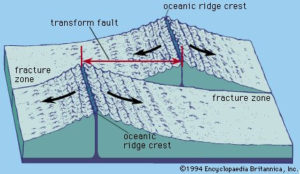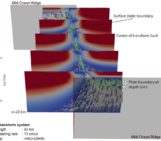
In 1965, JT Wilson published “A New Class of Faults and their Bearing on Continental Drift” (https://doi.org/10.1038/207343a0). This is one of the papers that led to a paradigm shift in Earth Sciences and would become one of the bases of plate tectonics. The concept of the transform fault, introduced in this paper in a very smart way, is fundamental in tectonics textbooks nowadays. Indeed many of us read it during our study years; however, it is such a classic that it is worth reading it once again!
The paper begins by stating the difference between transcurrent and the newly proposed transform faults, followed by the description of their different types of geometry. A transform is defined as “a junction where one [tectonic, ed.] feature changes into another”. Consequently, a transform fault is a fault which terminates abruptly at both ends (Figure 1); these terminations are either marked by an extensional “ridge” or by a compressional subduction “arc”. The different combinations of terminations indicate the possible geometries that transform faults can have.

Figure 1. Oceanic ridges offset by transform faults and fracture zones. The arrows show the direction of movement across the transform faults (image from https://www.britannica.com/science/transform-fault#ref540752).
In order to demonstrate the existence of the proposed geometries, the paper describes examples around the world that fit into these types. These examples include the termination of the Mid-Atlantic ridge, the Equatorial Atlantic fracture zones, the termination of the Carlsberg ridge in the Indian Ocean and the termination of the East Pacific ridge into the San Andreas fault.
The author understands the importance of his contribution to the acceptance and understanding of a debated concept at the time: the continental drift. Therefore, as part of his conclusion, he invites others to investigate transform faults further. This invitation was embraced by, for example, Sykes (1967) (seismological tests on sea-floor spreading), and Morgan (1968) (geometrical tests on plate tectonics).
Gino de Gelder, Gianluca Frasca and Folarin Kolawole participated in the discussion that preceded this post. They valued how this paper builds upon the essential work of researchers such as Anderson (about fault mechanics) and Marie Tharp (and Heezen and Ewing (1961)) about earthquake-bathymetry coupling. I would add the work on sea-floor spreading by Dietz (1961) (see discussion on Reddit) and Hess (1962). The contributors to the Reddit discussion also enjoyed how plain, black & white figures explain this simple (but not easy!) concept.
Folarin acknowledged the contribution of this paper to the understanding of continental-drift by introducing the idea of the compatibility of kinematics between the different types of plate boundaries. Gino highlighted how many of the plate boundaries presented in this work are still interpreted in the same way nowadays. Gianluca took a look at how transforms are currently subject of investigation regarding the potential for subduction initiation.
The elements in this virtual conversation show how “A New Class of Faults and their Bearing on Continental Drift” not only had a major role in the 1960’s nascent discussion of what we call today plate tectonics, but also how these concepts are still valid. Some of the works that made part of that discussion, particularly the work of Wilson (1966) and Morgan (1968), are open for comments in the Reddit Must-read TS community.
Written by Adriana Guatame-Garcia, Folarin Kolawole, Gino de Gelder and the TS Must-Read Team
References
Dietz, R. (1961). Continent and Ocean Basin Evolution by Spreading of the Sea Floor. Nature 190, 854–857
Heezen, B. C., Ewing, M. (1961). The Mid-Oceanic Ridge and its extension through the Arctic Basin. G.O. Raasch (Ed.), Geology of the Arctic — Proc. Intern. Symp. on Arctic Geology, 1st. University of Toronto Press, Toronto, Ont., 1, p.732
Hess, H. H. (1962). History of the ocean basin. Petrologic Studies. Volume to Honor A.F. Buddington, Geol. Soc. Am, New York, N.Y, pp. 599-620
Wilson J. T. (1966). Did the Atlantic Close and then Re-Open?. Nature 211, 676–681
Sykes, L.R. (1967). Mechanism of earthquakes and nature of faulting on the mid-oceanic ridges, Journal of Geophysical Research, 72, 5–27)
Morgan, W. J. (1968). Rises, trenches, great faults, and crustal blocks. Journal of Geophysical Research (1896-1977)Volume 73, Issue 6



